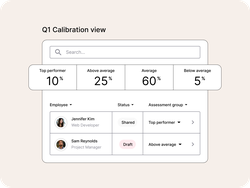
Performance review calibrations: What you need to know

When done right, performance reviews can motivate employees, drive development through helpful feedback, improve manager-employee relationships, and reward hard work. But, unfair bias and inconsistent ratings can frustrate employees and put certain individuals at a disadvantage. Enter performance review calibrations.
Calibration is a process that aims to make reviews fair and consistent across managers, departments, and even job levels. While it does take a bit of legwork from your HR team and managers, calibrations - approached correctly - can improve the accountability of your reviews and ensure every employee receives feedback that’s both fair and designed to support their growth at your company.
We’ve put together a brief guide explaining what performance management calibrations are, how you can implement them at your organization, and best practices to get your alignment conversations off the ground. These tips and best practices will help ensure that your next round of performance reviews are fair and objective for everyone involved.
What is performance review calibration?
Performance review calibration is a process in which managers discuss their proposed employee ratings with other managers. The goal is to find common ground that makes consistent employee performance evaluations possible. This practice is meant to limit bias in the performance review process and ensure managers agree on the criteria against which their direct reports will be rated.
For example, a more laid-back manager might be inclined to give every employee on their team a “5” because their employees did everything listed in their job description during that review cycle. On the other hand, a stricter manager might score even their top performer a “3” for meeting the same performance criteria.
Why might this happen? Well, in our second manager’s eyes, their hypothetical employee has only met expectations for their role, not exceeded them. Without going above and beyond, the second manager would consider a rating of 4 or 5 unwarranted. As such, two employees with identical performance may receive two very different scores because their managers weren’t aligned on what standard their respective teams should be held to.
Performance review calibration (also known as performance management calibration) enables managers to apply similar standards to each of their direct reports to ensure everyone in the department is ranked on the same scale. Calibrations can be done not only by department but also by employee level or job function. While a company should schedule performance review calibrations before every major review cycle, they can also be done anytime departments merge or businesses go through a merger and acquisition.
Why is performance management calibration important?
Performance review calibration is a crucial step in the employee review process for many reasons. As mentioned above, it ensures managers are on the same page and empowers them to rate employees more fairly, but that’s not even half of it. Here are some other reasons why performance calibrations are important for any business:
- Increase review accuracy. Unfortunately, one manager’s idea of a top performer might differ wildly from another’s - a difference that can dramatically hurt one team and help another. This is because come promotion and raise time, one manager’s team will have a significant leg up while the other’s chances will suffer. Calibration ensures reviews are more consistent and accurate.
- Properly acknowledge and reward high performance. Once the bar is set, managers can rate employees with more certainty and ensure everyone on their team gets the recognition and reward they deserve.
- Reduce bias. When managers rate their direct reports in a vacuum, they can only compare their direct reports to other teammates or their own idea of what performance should be. Without a calibration discussion, a manager might let unconscious bias influence their decisions and prevent specific reports from receiving a fair review.
- Uphold the credibility of the process. Being transparent with your employees and sharing how ratings are determined can help build trust in this often feared (and historically unpopular) practice. Calibrations don’t just ensure that reviews are more fair and equitable - they make it so employees believe the process is fair and equitable.
How do you calibrate a review?
An organization’s HR team is usually the driver of the calibration process, including building capability models and facilitating manager calibration discussions. If this is your first time overseeing rating alignment, we’ve outlined a step-by-step guide to leading performance management calibrations below:
- Employees nominate peers for feedback and share it with their manager
- The manager selects peer reviewers from the list provided
- Peers receive feedback requests and submit feedback
- Employees complete a self-reflection
- Managers gather feedback and self-reflection and write an evaluation
- Team’s managers meet for an alignment conversation
- Outputs completed by managers. People partners compile the feedback for calibration
- Calibration takes place
- Managers present constructive feedback and ratings to their employees
If we lost you somewhere between steps 1 and 9, don’t worry. Creating fair and useful performance review processes across your organization don’t have to be challenging. Culture Amp’s built-in calibrations capability makes it easy to access a holistic view of performance across your company empowers all organizations - no matter the size or industry - to run effective calibration and promotion committee meetings.
Performance review calibration best practices
While you’re almost a calibration pro at this point, you won’t want to kick off your own process until you hear these top tips - straight from our team of people scientists.
- Split performance and compensation conversation cycles. Having the two cycles run simultaneously adds a lot of work onto your managers’ already full plates and puts more pressure on your employees. Separate the two so employees can whole-heartedly focus on the feedback they receive and their professional growth.
- Know when to step in. Depending on the level of agreement, certain leadership groups might need a strong HR facilitator who is willing to step in during calibration conversations and challenge a decision or share feedback on any unusual or biased patterns that develop. Since the people team has a macro view of these sessions across the organization, they can provide valuable context and help ensure that conversations stay on track.
- Communicate your performance approach. Ensure your employees are aware of the rating criteria and process prior to their review. This gives them more time to understand the approach you’ve taken and why.
- Nothing should be a surprise. While performance reviews are a crucial component of the continuous feedback model, they aren’t the only time your managers and employee should share feedback and discuss professional growth. These topics (and more) should regularly be addressed in weekly 1-on-1s or other casual check-ins, meaning none of the topics discussed during an employee’s review should be a surprise. Because your employees should have a good idea of what to expect and know your calibration conversations have improved the fairness of performance scores, they can approach these conversations calmly and with an open mind.
Performance management calibrations are the key to equitable performance reviews. Having alignment conversations and tracking performance ratings can help you understand employee performance across the company and ensure your leaders are providing useful and equitable reviews.

Create a fair and useful performance review process across your organization
Reduce bias, track employee performance across the company, and identify opportunities for alignment.




